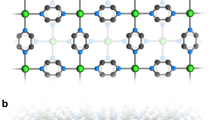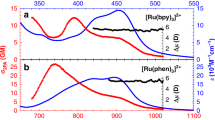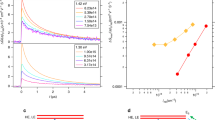Abstract
THE potential development of optoelectronic devices based on the nonlinear polarization of molecular materials has aroused much recent interest1,2. The search for large second-order electric susceptibilities (that is, proportional to the square of an applied electric field) has concentrated on acentric organic or organometallic chromophores with an organic π-electron system coupling electron donor and acceptor groups3–6. It is conceivable that mixed-valence compounds characterized by an intervalence charge-transfer (IVCT) transition7, in which the donor and acceptor centres are both metal atoms, might also have the potential to provide a large second-order response8, but this possibility has not been widely explored. Here we report the first hyperpolarizability, β, of a bimetallic complex ion, [(CN)5Ru-μCN-Ru(NH3)5]- (I in Fig. 1), and a novel organometallic analogue, [(η5-C5H5)Ru(PPh3)2-μ-CN-Ru(NH3)5]3+ (II). Measurements of β (which is related to the bulk second-order response) in solution at a wavelength of 1,064 nm using the newly developed hyper-Rayleigh scattering technique9,10 give values greater than 10–27 e.s.u., which are among the largest reported for solution species. The ease with which the energy of the IVCT transition can be modified suggests that there may be considerable potential for this class of chromophore in nonlinear optical devices.
This is a preview of subscription content, access via your institution
Access options
Subscribe to this journal
Receive 51 print issues and online access
$199.00 per year
only $3.90 per issue
Buy this article
- Purchase on Springer Link
- Instant access to full article PDF
Prices may be subject to local taxes which are calculated during checkout
Similar content being viewed by others
References
Eaton, D. F. Science 253, 281–287 (1991).
Dorn, R., Baums, D., Kersten, P. & Regener, R. Adv. Mater. 4, 464–473 (1992).
Williams, D. J. Angew. Chem. int. Ed. Engl. 23, 690–703 (1984).
Marder, S. R., Beratan, D. N. & Cheng, L.-T. Science 252, 103–106 (1991).
Cheng, L.-T., et al. J. phys. Chem. 95, 10643–10652 (1991).
Cheng, L.-T., et al. J. phys. Chem. 95, 10631–10643 (1991).
Robin, M. & Day, P. Adv. inorg. Radiochem. 10, 247–422 (1967).
Lehn, J.-M. in Nonlinear Optical Properties of Organic Molecules and Crystals, Vol. II (eds Chemla, D. S. & Zyss, J.) 215–220 (Academic, London, 1987).
Clays, K. & Persoons, A. Rev. Sci. Instrum. 63, 3285–3289 (1992).
Clays, K. & Persoons, A. Phys. Rev. Lett. 66, 2980–2983 (1991).
Zyss, J. & Chemla, D. S. in Nonlinear Optical Properties of Organic Molecules and Crystals, Vol. I (eds Chemla, D. S. & Zyss, J.) 23–192 (Academic, Orlando, 1987).
Jongerius, M. J., Drenten, R. R. & Droste, R. B. J. Philips J. Res. 46, 231–265 (1992).
Granestrand, P., et al. Electron. Lett. 50, 816 (1987).
Williams, D. J. in Nonlinear Optical Properties of Organic Molecules and Crystals. Vol. I (eds Chemla, D. S. & Zyss, J.) 405–436 (Academic, Orlando, 1987).
Möhlmann, G. R., et al. Proc. SPIE 1337, 215 (1990).
Kanis, D. R., Marks, T. J. & Ratner, M. A. Int. J. Quant. Chem. 43, 61–82 (1992).
Green, M. L. H., et al. Nature 330, 360–362 (1987).
Cheng, L.-T., Tam, W. & Meredith, G. R. Mol. Cryst. Liq. Cryst. 189, 137–153 (1990).
Calabrese, J. C., Cheng, L.-T., Green, J. C., Marder, S. R. & Tam, W. J. Am. chem. Soc. 113, 7227–7232 (1991).
Flyzanis, C. & Dulcic, A. Opt. Commun. 25, 402–406 (1978).
Girling, I. R., Cade, N. A., Kolinsky, P. V. & Montgomery, C. M. Electron. Lett. 21, 169–170 (1985).
Ashwell, G. J., Hargreaves, R. C., Baldwin, C. E., Bahra, G. S. & Brown, C. R. Nature 357, 393–395 (1992).
Vogler, A. & Kisslinger, J. J. Am. chem. Soc. 104, 2311–2312 (1982).
Hush, N. S. Prog. inorg. Chem. 8, 391 (1967).
Hush, N. S. Chem. Phys. 10, 391 (1975).
Oudar, J. L. & Chemla, D. S. J. chem. Phys. 66, 2664–2668 (1977).
Oudar, J. L. J. chem. Phys. 67, 446–457 (1977).
Marder, S. R., Beratan, D. N., Tiemann, B. G., Cheng, L.-T. & Tam, W. in Organic Materials for Non-Linear Optics (eds Hann, R. A. & Bloor, D.) 165–175 (Royal Society of Chemistry, Cambridge, UK, 1990).
Author information
Authors and Affiliations
Rights and permissions
About this article
Cite this article
Laidlaw, W., Denning, R., Verbiest, T. et al. Large second-order optical polarizabilities in mixed-valency metal complexes. Nature 363, 58–60 (1993). https://doi.org/10.1038/363058a0
Received:
Accepted:
Issue Date:
DOI: https://doi.org/10.1038/363058a0
This article is cited by
-
Studies on linear and nonlinear optical properties of 4-N,N-dimethylamino-4′-N′-methyl-stilbazolium 2,4,6-trimethylbenzenesulfonate crystal
Journal of Materials Science: Materials in Electronics (2018)
-
Synthesis, characterization and third-order nonlinear optical properties of ruthenium(II) complexes containing 2-(4-nitrophenyl)imidazo[4,5-f] [1,10]phenanthroline
Transition Metal Chemistry (2004)
-
Chemical studies on the nonlinear optics of coordination compounds
Chinese Science Bulletin (2001)
-
Propeller molecules take off
Nature (1995)
Comments
By submitting a comment you agree to abide by our Terms and Community Guidelines. If you find something abusive or that does not comply with our terms or guidelines please flag it as inappropriate.



